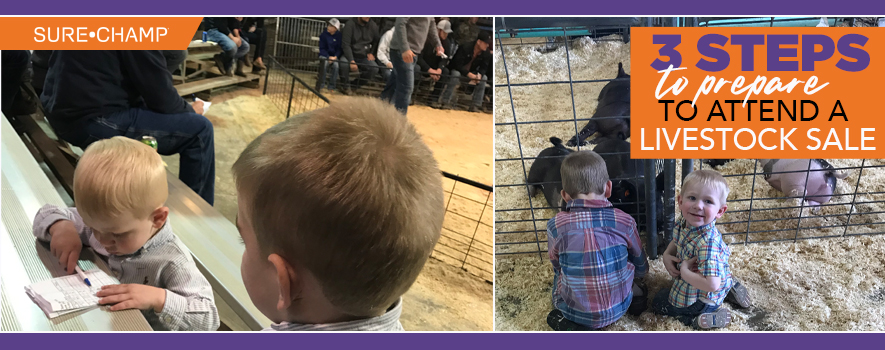
There’s nothing quite as exhilarating as an auctioneer’s chant climbing as bids are coming in. When he pounds his gavel and says, “sold” one lucky buyer wins the bid and the next animal is already being auctioned. Auctions are fast-paced and for a novice attendee can be somewhat intimidating. However, if you prepare in advance, you’ll be the one giving your bid and showing your buyer number when the gavel falls.
Although attending sales is memorable, and some go just to see friends and neighbors or check out particular sire groups, typically when you attend a sale, you have a goal in mind: to purchase an animal to put back into your herd or flock or for a show animal. But it isn’t just as easy as showing up. Especially if you have never been to a sale before.
Before you go.
Make sure you do your homework before you ever leave home for the sale. Establish your budget with your parent, FFA advisor, 4-H leader or whoever is helping you with your project. Once you know your budget, decide what your priorities are. If you are looking for a market animal, know your endpoint so you can buy one that will meet that target. If you are looking for a breeding animal, are you using it strictly for a show animal or will you be adding it to your own herd or flock?
Regardless of the species you are intending to buy, research the breeder/seller. Are they reputable within the industry? Are they known to help young people with projects after the sale? These are things you can likely find out from looking at their website or social media platforms, talking to others or simply by calling and talking to the person prior to the sale.
Research the offering. Most sales will have a sale book, photos or videos posted online prior to the sale, along with pedigree and birthdates. This is a great way to see what the seller is offering and to get some idea of what you will see when you get to the sale.
Finally, be prepared when you leave home to pay for your animal and bring it home, unless you have already made prior arrangements with the seller. Take your check book or cash, a trailer or popper, and make sure you have a notebook and pen to take notes on once you get to the sale location.
At the sale.
Sales are an important day for livestock breeders. For most, this is their pay day for the year, and it is day they take very seriously; therefore, you should take attending the sale seriously too. Show respect to the property where the sale is hosted – the farm or ranch, a livestock auction market or fairgrounds, because the breeder has taken special care and consideration to make sure the facility is in tip-top shape.
Be sure to arrive to the sale with ample time to preview the lots, usually a few hours before the sale starting time. You want to make sure you have time to see all the animals that interest you, the ones you think will be in your budget and any that might work for plans b or c. Upon arrival, pick up a sale book (if you don’t already have one), a sale order and a pen map if they are available. Register for a buyer’s number; you will likely need a driver’s license or some form of photo I.D. to do so. Then, start previewing the animals.
When it comes time to look at animals, keep these things in mind. Know how to identify the animals. If you are looking at cattle, sheep or goats, they will likely have an ear tag that corresponds to their lot number. When looking at pigs, you will need to know how to read ear notches. If you are unsure of a notch, be sure to ask someone that is in the pen; it would be a shame to get zeroed in on the wrong pig. Be sure to remain quiet around the livestock. Sure, they are probably used to lookers, but there is likely a lot of activity and they don’t need any extra noise or distraction.
If you are looking at cattle, be sure to shut the gates behind you as you walk through pens. If you are at a pig sale, and plastic boots or a foot bath are provided for biosecurity, use them. If you have never met the breeder before, introduce yourself or ask a common acquaintance to introduce you. Have some questions prepared about an animal you are interested in such as the production record of the animal’s mother or how previous offspring have performed.
Take notes about the animals you definitely like, ones that you don’t like and ones that would work. Speak quietly among the people in your group, as to not offend anyone. When it is getting close to sale time, be sure to take a seat where you feel comfortable setting and bidding.
When it comes to bidding, don’t be afraid to wave your hand to get the bid taker or auctioneer’s attention. Once they know that you are interested in an animal, they will come back to you when you have been outbid. Be sure you know where the current bid is, and once you have reached your limit, stop bidding. It is perfectly acceptable to get outbid on an animal; and hopefully you have more than one selected. If you win the bid, be ready to show your buyer’s number quickly, and if numbers are not provided, state your name clearly and loudly enough for the bid taker to hear.
After the Sale.
Congratulations! You have purchased your animal at live auction. It is now time to go to the settlement desk, write the check and get load-out instructions. Unless you are familiar with the breeder and have made prior arrangements, you should always be prepared to pay and pick up your animal the day of the sale. If you are buying registered livestock, be sure the seller knows which name to transfer the animal to.
As you prepare to take your new animal home, ask the seller some basic health and nutrition history on your new purchase. Find out how much and what type of feed the animal has been getting. Ask about the breeder’s vaccination program so you know when the animal was last vaccinated.
Attending a sale is often the first step in getting your new livestock project for the year. Sales are a great networking tool, an opportunity to see livestock by multiple sires and the chance to learn from those with more experience in the business. Once you’ve brought your new animal home, it’s time to work with that animal EVERY. DAY. as you #preptowin in the show ring and in life.

